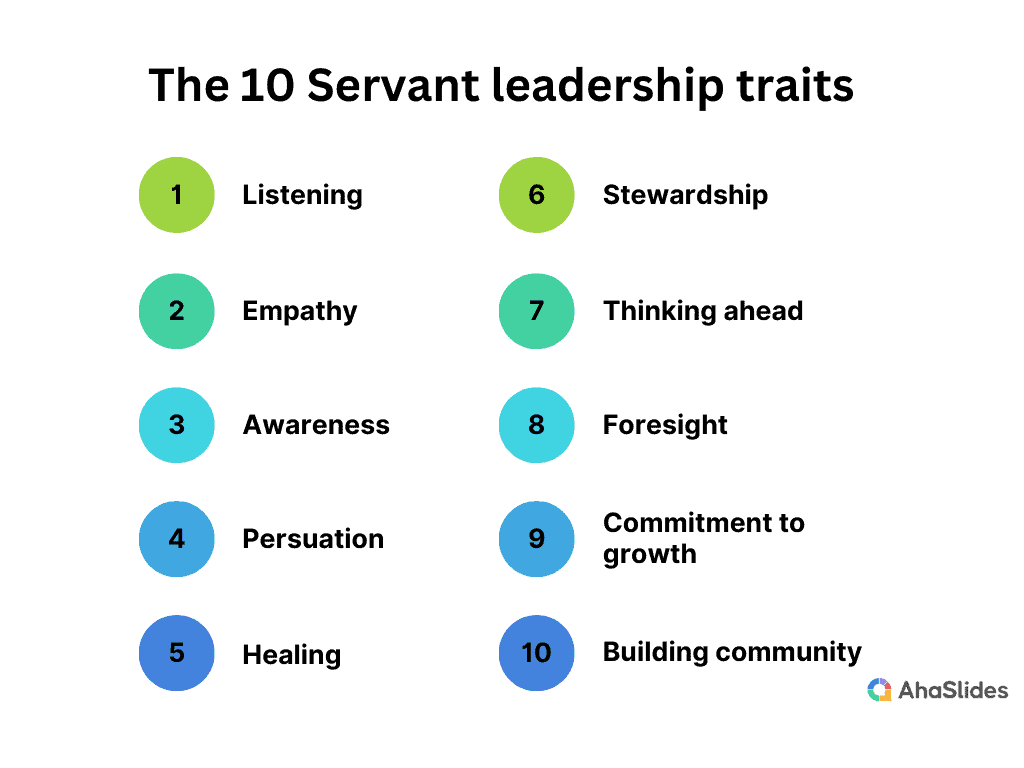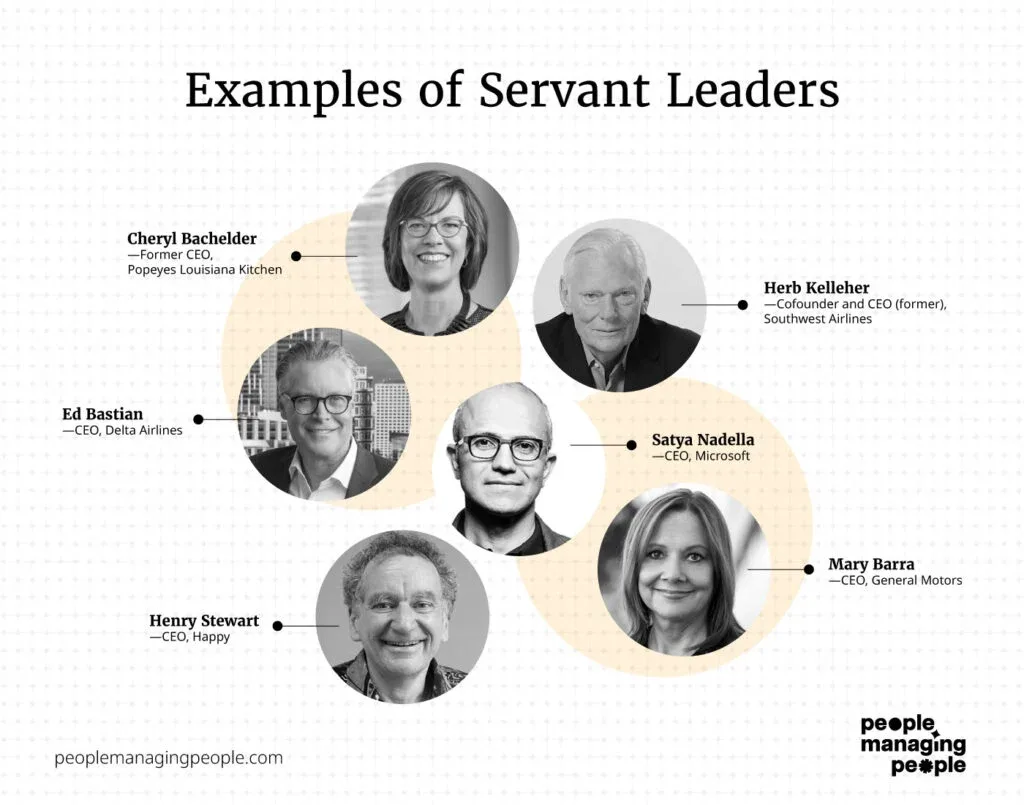"Leadership is not about being in control. It is about empowering people to be better than you are." - Mark Yarnell
Leadership style is a controversial topic, and there are uncountable leadership styles that have emerged throughout history.
From autocratic and transactional approaches to transformational and situational leadership, each style brings its unique strengths and weaknesses.
However, people nowadays talk more about another revolutionary concept, that dates back to early 1970, called Servant Leadership which has continued to inspire leaders worldwide.
So what are Servant Leadership examples, who are considered good servant leaders? Let's check out the top 14 Servant Leadership Examples, plus a full demonstration of the Servant Leadership model.
Overview
| Who invented Servant Leadership concept? | Robert Greenleaf |
| When was servant leadership first introduced? | 1970 |
| Who is the most famous servant leader? | Mother Teresa, Martin Luther King Jr., Herb Kelleher, Cheryl Bachelder |
Table of Contents
- What is Servant Leadership?
- 7 Pillars of Servant Leadership
- Best Servant Leadership Examples
- Servant Leadership Examples in Real Life
- How to Practice Servant Leadership?
- Frequently Asked Questions
What is Servant Leadership?
Robert Greenleaf is the father of the concept of Servant Leadership. In his words, "Good leaders must first become good servants." He linked this leadership style with the art of leading with humility, empathy, and a genuine desire to serve others.
At its core lies the belief that the most effective servant leaders are not those who seek power, but those who prioritize the growth, well-being, and success of their team members.
Greenleaf's definition of a Servant Leader is one who puts the needs of others first and seeks to uplift and support those they lead. Such leaders actively listen, empathize, and understand the hopes and dreams of their team members, working tirelessly to help them achieve personal and professional growth.

7 Pillars of Servant Leadership
Servant leadership is a leadership philosophy that emphasizes serving and empowering others, rather than a traditional top-down approach. According to James Sipe and Don Frick, the seven pillars of servant leadership are principles that frame this leadership style. They are:
- Person of Character: The first pillar emphasizes the importance of integrity and moral character in a servant leader. Leaders with strong character are trustworthy, honest, and consistently act in alignment with their values.
- Putting People First: Servant leaders prioritize the needs and well-being of their team members. They focus on developing and empowering their employees, ensuring their growth and success are at the forefront of leadership decisions.
- Skilled Communicator: Effective communication is a crucial aspect of servant leadership. Leaders should be active listeners, practice empathy, and foster open and transparent dialogue with their team.
- Compassionate Collaborator: Servant leaders are compassionate and collaborative in their approach. They encourage teamwork, actively involve their team members in decision-making, and promote a sense of community within the organization.
- Foresight: This pillar highlights the importance of vision and long-term thinking. Servant leaders have a clear vision of the future and work to align their team with the organization's mission and values.
- Systems Thinker: Servant leaders understand the interconnectedness of the organization's systems and processes. They consider the broader impact of their decisions and actions on the organization as a whole.
- Ethical Decision-Maker: Ethical decision-making is a fundamental pillar of servant leadership. Leaders consider the ethical implications of their choices and prioritize the greater good of the organization and its stakeholders.

Take your team development to the next level With AhaSlides
Add more fun with best live poll, quizzes and games, all available on AhaSlides presentations, ready to engage your crowd!
🚀 Sign Up for Free
Best Servant Leadership Examples

If you are still questioning the servant leadership style, here are 10 servant leadership examples that describe perfectly the fundamental traits of servant leaders.
#1. Listening
One of the best servant leadership examples comes with actively listening to team members and stakeholders. Leaders seek to understand their perspectives, concerns, and aspirations, creating an environment where everyone's voice is heard and valued.
#2. Empathy
One of the must-have servant leadership examples, imagine a leader who can put themselves in others' shoes, truly understanding their feelings and experiences. This leader shows compassion and cares about their team members' well-being.
#3. Awareness
Servant leaders know themselves well, including their strengths and weaknesses. They're emotionally intelligent, which helps them relate to their team and make better decisions.
#4. Persuasion
Instead of bossing people around, this leader inspires and motivates through their passion and vision. They use persuasion, not authority, to unite the team around common goals.
#5. Healing
Healing ability is also among the best servant leadership examples. When conflicts arise, a servant leader addresses them with empathy and kindness. They foster a sense of unity, helping their team heal and move forward together.
#6. Stewardship
Another servant leadership example calls for a stewardship attitude. They act as a caring steward, ensuring the company's values are upheld and considering the long-term impact of decisions.
#7. Thinking ahead
A forward-thinking mindset and proactivity are other great servant leadership examples. They anticipate challenges and opportunities, making strategic decisions that benefit the organization and its members in the long run.
#8. Foresight
It is the ability to see beyond the present and anticipate future challenges and opportunities. They have a clear vision of where they want to lead their team or organization, enabling them to make strategic decisions with long-term impact.
#9. Commitment to growth
Their dedications to personal and professional growth are good servant leadership examples as well. When leading by example, they encourage their team to have opportunities to learn and develop.
#10. Building community
They prioritize creating a supportive and collaborative work environment, where team members feel valued, included, and connected to a shared purpose.
Servant Leadership Examples in Real Life

In the world of servant leadership, success is not measured solely by financial gains or individual accolades, but by the impact a leader has on the lives of others. Here are some excellent real-life servant leadership examples who become a force for positive change, uniting individuals and transforming lives for the better.
Servant Leadership Examples #1: Nelson Mandela
A shining beacon of servant leadership examples, Nelson Mandela, the anti-apartheid revolutionary and former President of South Africa, exemplified compassion, forgiveness, and a deep commitment to serving others. Despite enduring decades of imprisonment and hardship, Mandela never wavered in his dedication to the welfare of his people, promoting unity and reconciliation over vengeance.
Servant Leadership Examples #2: Warren Buffett
Warren Buffett, the billionaire CEO of Berkshire Hathaway. Buffett embodies a high-profile example of a servant leadership style who has given away his immense wealth to charitable causes. He has contributed billions of dollars to address global health, education, poverty, and other societal challenges.
Servant Leadership Examples #3: Mahatma Gandhi
Mahatma Gandhi is widely regarded as one of the greatest servant leadership examples in history. Gandhi was an exceptional listener and empathetic communicator. He sought to understand the concerns and aspirations of people from all walks of life, building bridges and fostering unity among diverse communities.
Servant Leadership Examples #4: Howard Schultz
Howard Schultz, the founder of Starbucks, is often considered a prime example of servant leadership. Schultz prioritized the well-being and development of Starbucks' employees. Schultz was committed to the ethical sourcing of coffee beans and sustainability. Starbucks' ethical sourcing program, Coffee and Farmer Equity (C.A.F.E.) Practices, aimed to support coffee farmers and promote environmentally friendly practices.
How to Practice Servant Leadership?
In today's rapidly changing landscape, characterized by unprecedented challenges, servant leadership offers a guiding light - a reminder that good leadership is not about the pursuit of power or recognition; it is about dedicating oneself to the betterment of others.
It is time for leaders to put effort into practicing servant leadership in organizations. Here are several suggestions that individuals and organizations can
- Invest in team development
- Seek out feedback
- Understand each team member’s strengths
- Delegate responsibilities
- Eliminate interruptions from conversations.
⭐ Want more inspiration on training, feedback collecting, and team-buildings? Leverage AhaSlides right away to give your team members a comfortable place to connect, generate ideas, share feedback, and continue learning. Try AhaSlides today and take your team's development to the next level!
- Coaching Style of Leadership in 2025 | An Ultimate Guide with Examples
- Top 8 Examples of Transactional Leadership in 2025
- What is Autocratic Leadership? Ways to Improve it in 2025!
Frequently Asked Questions
What is an example of a servant leader organization?
One prominent example of a servant leader organization is The Ritz-Carlton Hotel Company. The Ritz-Carlton is known for its exceptional customer service and commitment to creating memorable experiences for its guests.
What is an example of servant leadership in school?
An excellent example of servant leadership in a school setting is the role of a principal who embodies the principles of servant leadership in their interactions with students, teachers, and staff.
What is servant leadership in today's society?
In today's servant leadership style, leaders still focus on their employees' needs, before considering their own. As Servant leadership is not a one-size-fits-all model, it adapts and molds itself to the unique needs of the people and organizations it serves.
How can you show servant leadership?
If you want to show the skills of servant leadership, techniques can vary from listening attentively to others without interrupting or judging, putting yourself in others' shoes to understand their feelings and experiences, or respecting the diversity of ideas, backgrounds, and experiences within your team or organization.
Ref: Ramsey Solutions | Indeed







